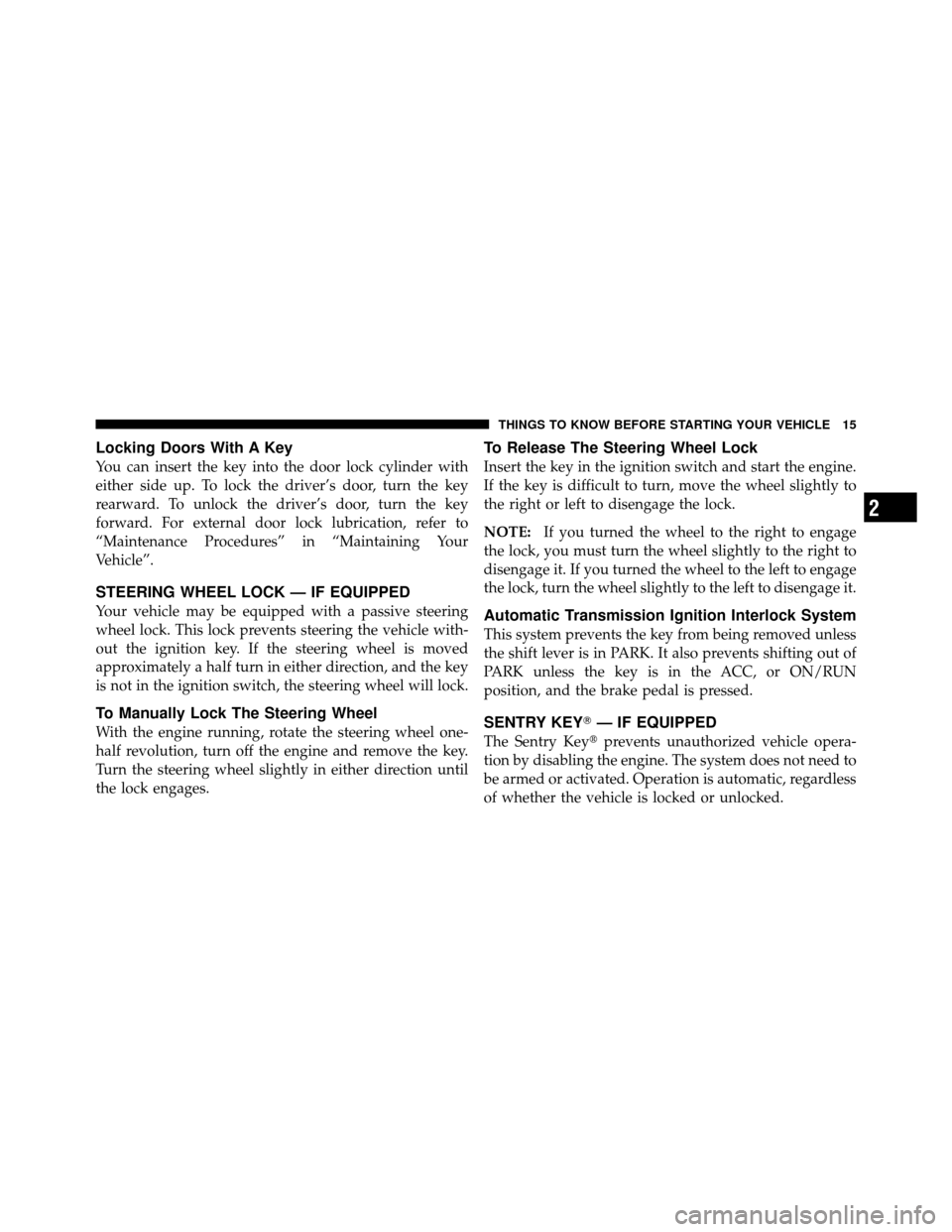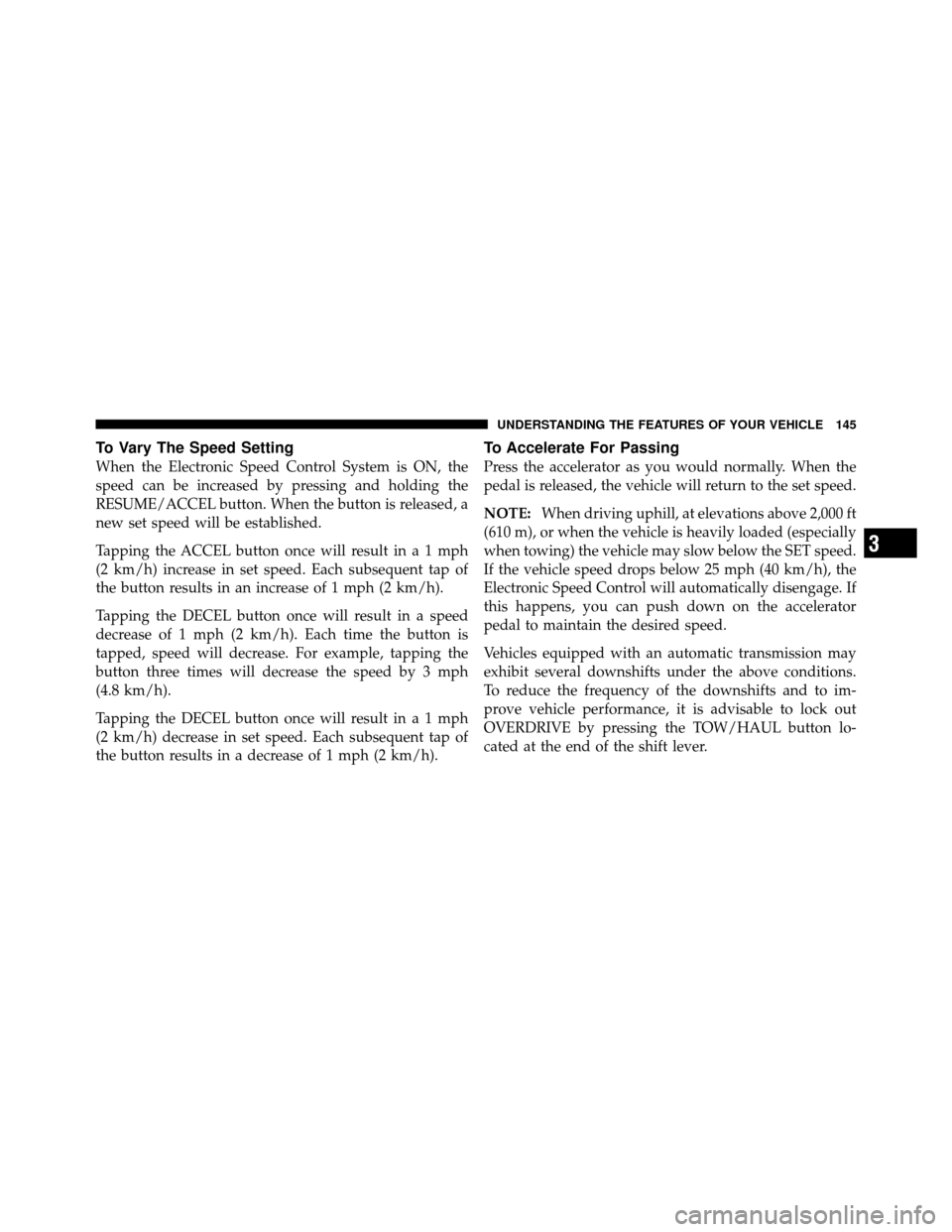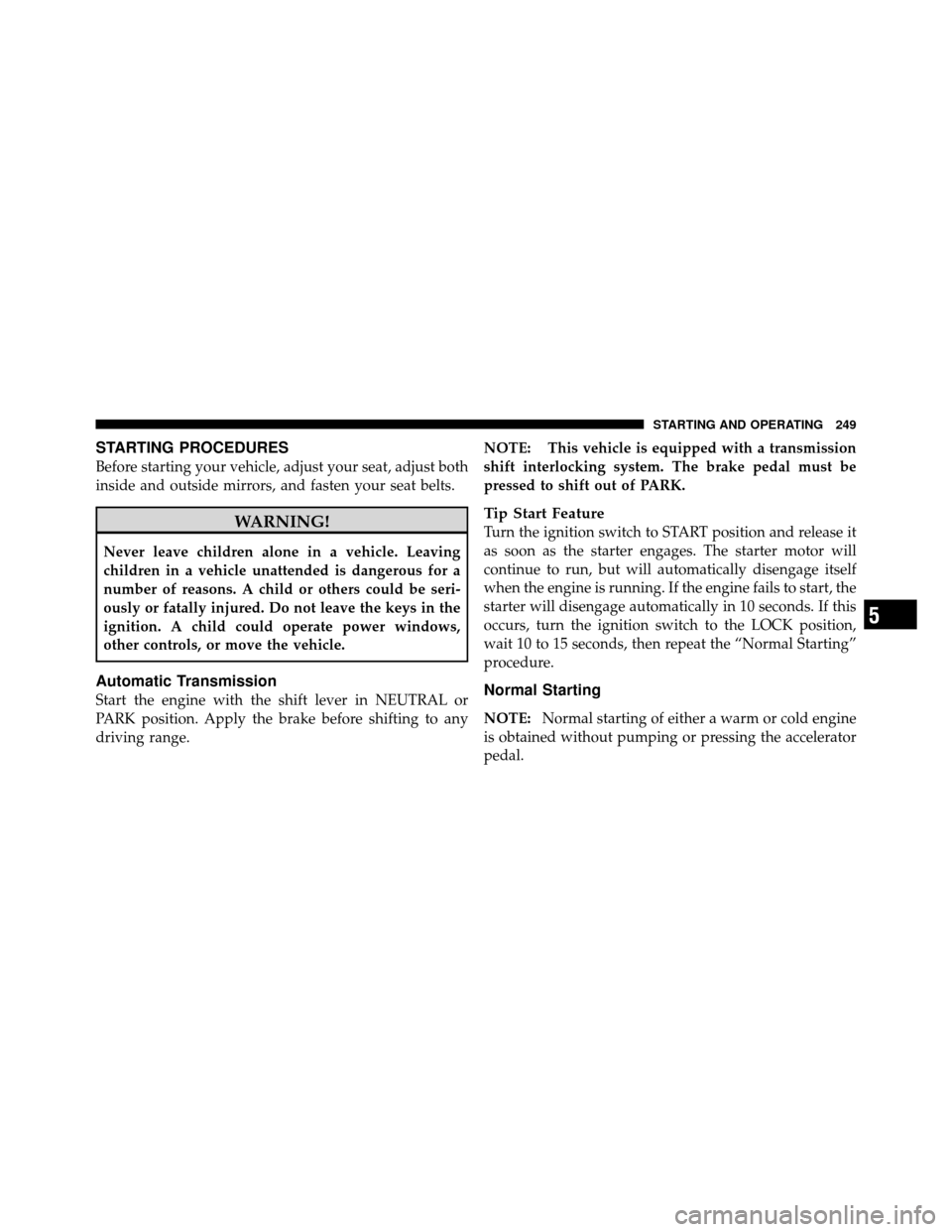Page 11 of 452
THINGS TO KNOW BEFORE STARTING YOUR VEHICLE
CONTENTS
�A Word About Your Keys ................. 12
▫ Ignition Key Removal .................. 12
▫ Locking Doors With A Key .............. 15
� Steering Wheel Lock — If Equipped ......... 15
▫ To Manually Lock The Steering Wheel ...... 15
▫ To Release The Steering Wheel Lock ........ 15
▫ Automatic Transmission Ignition Interlock
System ............................. 15 �
Sentry Key� — If Equipped ............... 15
▫ Replacement Keys ..................... 17
▫ Customer Key Programming ............. 17
� Vehicle Security Alarm — If Equipped ........ 18
▫ To Arm The System ................... 19
▫ To Disarm The System ................. 19
� Illuminated Entry ...................... 20
▫ Vehicles Equipped With Power Door Locks . . . 20
2
Page 14 of 452
A WORD ABOUT YOUR KEYS
The authorized dealer that sold you your vehicle has the
key code numbers for your vehicle locks. These numbers
can be used to order duplicate keys from your authorized
dealer. Ask your authorized dealer for these numbers
and keep them in a safe place.
Ignition Key Removal
Automatic Transmission
1. Place the shift lever in PARK.
2. Turn the ignition switch to the LOCK position.
3. Remove the key from the ignition lock cylinder.
Ignition Key
12 THINGS TO KNOW BEFORE STARTING YOUR VEHICLE
Page 17 of 452

Locking Doors With A Key
You can insert the key into the door lock cylinder with
either side up. To lock the driver’s door, turn the key
rearward. To unlock the driver’s door, turn the key
forward. For external door lock lubrication, refer to
“Maintenance Procedures” in “Maintaining Your
Vehicle”.
STEERING WHEEL LOCK — IF EQUIPPED
Your vehicle may be equipped with a passive steering
wheel lock. This lock prevents steering the vehicle with-
out the ignition key. If the steering wheel is moved
approximately a half turn in either direction, and the key
is not in the ignition switch, the steering wheel will lock.
To Manually Lock The Steering Wheel
With the engine running, rotate the steering wheel one-
half revolution, turn off the engine and remove the key.
Turn the steering wheel slightly in either direction until
the lock engages.
To Release The Steering Wheel Lock
Insert the key in the ignition switch and start the engine.
If the key is difficult to turn, move the wheel slightly to
the right or left to disengage the lock.
NOTE:If you turned the wheel to the right to engage
the lock, you must turn the wheel slightly to the right to
disengage it. If you turned the wheel to the left to engage
the lock, turn the wheel slightly to the left to disengage it.
Automatic Transmission Ignition Interlock System
This system prevents the key from being removed unless
the shift lever is in PARK. It also prevents shifting out of
PARK unless the key is in the ACC, or ON/RUN
position, and the brake pedal is pressed.
SENTRY KEY� — IF EQUIPPED
The Sentry Key� prevents unauthorized vehicle opera-
tion by disabling the engine. The system does not need to
be armed or activated. Operation is automatic, regardless
of whether the vehicle is locked or unlocked.
2
THINGS TO KNOW BEFORE STARTING YOUR VEHICLE 15
Page 31 of 452
If you press the power door LOCK switch while the key
is in the ignition, and any front door is open, the power
locks will not operate. This prevents you from acciden-
tally locking your keys in the vehicle. Removing the key,
or closing the door, will allow the locks to operate. Achime will sound if the key is in the ignition switch and
the driver’s door is open, as a reminder to remove the
key.
Automatic Door Locks — If Equipped
The doors will lock automatically if all of the following
conditions are met:
1. The Automatic Door Locks feature is enabled
2. The transmission is in gear
3. All doors are closed
4. The throttle is pressed
5. The vehicle speed is above 15 mph (24 km/h)
6. The doors were not previously locked using the power
door lock switch or Remote Keyless Entry (RKE)
transmitter
Power Door Lock Switch
2
THINGS TO KNOW BEFORE STARTING YOUR VEHICLE 29
Page 147 of 452

To Vary The Speed Setting
When the Electronic Speed Control System is ON, the
speed can be increased by pressing and holding the
RESUME/ACCEL button. When the button is released, a
new set speed will be established.
Tapping the ACCEL button once will result ina1mph
(2 km/h) increase in set speed. Each subsequent tap of
the button results in an increase of 1 mph (2 km/h).
Tapping the DECEL button once will result in a speed
decrease of 1 mph (2 km/h). Each time the button is
tapped, speed will decrease. For example, tapping the
button three times will decrease the speed by 3 mph
(4.8 km/h).
Tapping the DECEL button once will result ina1mph
(2 km/h) decrease in set speed. Each subsequent tap of
the button results in a decrease of 1 mph (2 km/h).
To Accelerate For Passing
Press the accelerator as you would normally. When the
pedal is released, the vehicle will return to the set speed.
NOTE:When driving uphill, at elevations above 2,000 ft
(610 m), or when the vehicle is heavily loaded (especially
when towing) the vehicle may slow below the SET speed.
If the vehicle speed drops below 25 mph (40 km/h), the
Electronic Speed Control will automatically disengage. If
this happens, you can push down on the accelerator
pedal to maintain the desired speed.
Vehicles equipped with an automatic transmission may
exhibit several downshifts under the above conditions.
To reduce the frequency of the downshifts and to im-
prove vehicle performance, it is advisable to lock out
OVERDRIVE by pressing the TOW/HAUL button lo-
cated at the end of the shift lever.
3
UNDERSTANDING THE FEATURES OF YOUR VEHICLE 145
Page 184 of 452

If the ABS light remains on or turns on while driving, it
indicates that the Anti-Lock portion of the brake system
is not functioning and that service is required. However,
the conventional brake system will continue to operate
normally if the BRAKE warning light is not on.
If the ABS light is on, the brake system should be serviced
as soon as possible to restore the benefits of Anti-Lock
brakes. If the ABS light does not illuminate when the
ignition switch is turned to the ON/RUN position, have
the light inspected by an authorized dealer.
12. Oil Pressure Warning LightThe Oil Pressure Warning Light illuminates when
the engine oil pressure has become too low. For a
bulb check, this light will come on momentarily when the
ignition is turned to ON/RUN. If the light turns on while
driving, stop the vehicle and shut off the engine as soon
as possible. Immediate service should be obtained. 13. Tachometer
The tachometer gauge measures engine revolutions-per-
minute (RPM x 1000).
14. Shift Lever Indicator
The electronic shift lever indicator is self-contained
within the instrument cluster. It displays the position of
the automatic transmission shift lever, and the relation of
each position to all other positions. The display will place
a box around the selected transmission range (PRND21).
If the PRNDL displays only the characters PRND21 (no
boxes), have the system checked by an authorized dealer.
15. Trip Odometer
The trip odometer shows individual trip mileage. To
switch from odometer to trip odometer, press and release
the trip odometer button.
To reset a trip odometer, display the trip odometer then
push and hold the button until the display resets (ap-
proximately two seconds).
182 UNDERSTANDING YOUR INSTRUMENT PANEL
Page 247 of 452
STARTING AND OPERATING
CONTENTS
�Starting Procedures .................... 249
▫ Automatic Transmission ............... 249
▫ Normal Starting ..................... 249
▫ Extreme Cold Weather
(Below –20°F Or –29°C) ................ 250
▫ If Engine Fails To Start ................ 250
▫ After Starting ....................... 251
� Engine Block Heater — If Equipped ........ 251�
Automatic Transmission ................. 252
▫ Key Ignition Park Interlock ............. 253
▫ Brake/Transmission Interlock System ...... 253
▫ Automatic Transmission ............... 253
▫ Gear Ranges ........................ 253
� Four-Wheel Drive Operation — If Equipped . . 258
▫ Transfer Case Operating Information/
Precautions ......................... 258
▫ Shifting Procedure ................... 262
5
Page 251 of 452

STARTING PROCEDURES
Before starting your vehicle, adjust your seat, adjust both
inside and outside mirrors, and fasten your seat belts.
WARNING!
Never leave children alone in a vehicle. Leaving
children in a vehicle unattended is dangerous for a
number of reasons. A child or others could be seri-
ously or fatally injured. Do not leave the keys in the
ignition. A child could operate power windows,
other controls, or move the vehicle.
Automatic Transmission
Start the engine with the shift lever in NEUTRAL or
PARK position. Apply the brake before shifting to any
driving range.NOTE: This vehicle is equipped with a transmission
shift interlocking system. The brake pedal must be
pressed to shift out of PARK.
Tip Start Feature
Turn the ignition switch to START position and release it
as soon as the starter engages. The starter motor will
continue to run, but will automatically disengage itself
when the engine is running. If the engine fails to start, the
starter will disengage automatically in 10 seconds. If this
occurs, turn the ignition switch to the LOCK position,
wait 10 to 15 seconds, then repeat the “Normal Starting”
procedure.
Normal Starting
NOTE:
Normal starting of either a warm or cold engine
is obtained without pumping or pressing the accelerator
pedal.
5
STARTING AND OPERATING 249